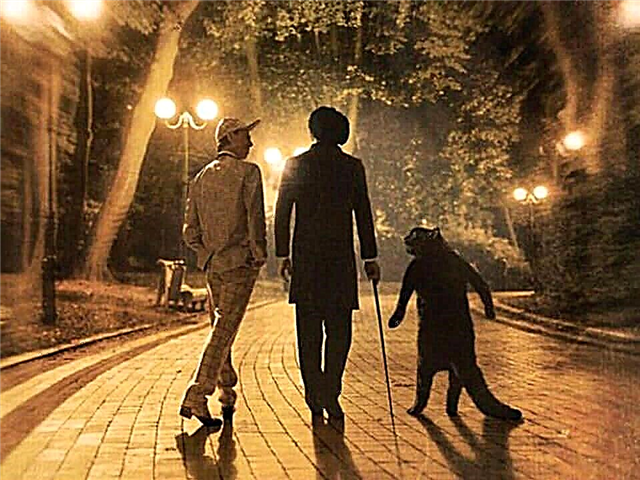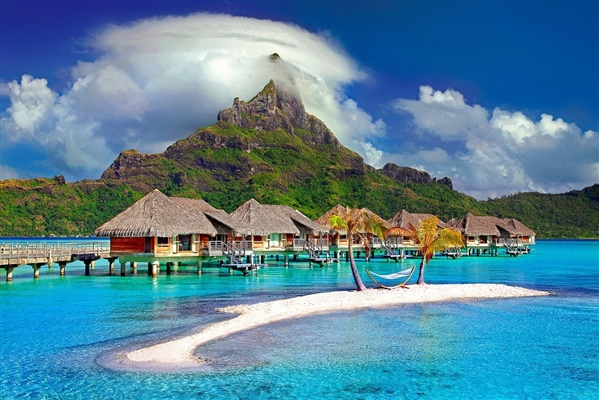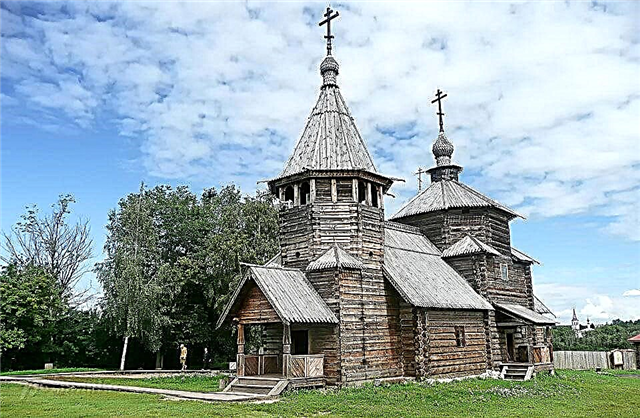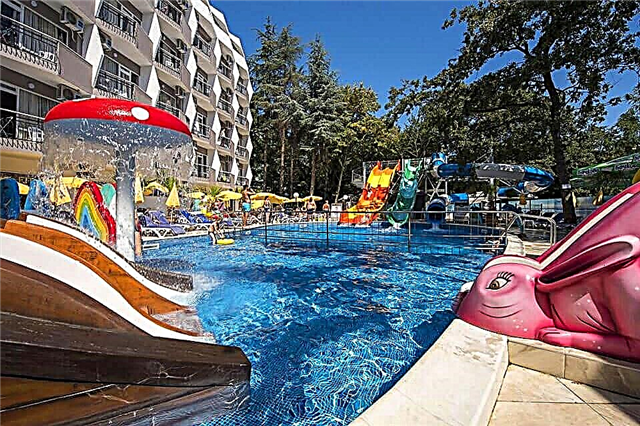Address: Moscow Kremlin, between Vodovzvodnaya and Armory towers
Build date: 1490 year
Tower height: with a star of 54.05 m.
There is a ruby star on the tower
Coordinates: 55 ° 44'56.2 "N 37 ° 36'45.7" E
Content:
Short story
Borovitskaya Tower belongs to the southwestern towers that adorn the wall of the Moscow Kremlin. The building is located next to three other attractions - the Bolshoi Kamenny Bridge, an area called Borovitskaya and Alexander Garden.
According to the legend, the tower owes its name to an ancient pine forest that once covered the hill on which Moscow was built. But there is another version, which indicates that the tower received the name "Borovitskaya" from the builders of the Kremlin, who lived in the city of Borovsk.

View of the tower from st. Borovitskaya
The Borovitskaya Tower adorned Moscow in 1490, and the work on its construction was supervised by an Italian architect named Solari, who arrived in the capital city of Russia at the direction of Vasily III. In the same year, the architect erected a wall connecting the Borovitskaya and Vodovzvodnaya (Sviblova) towers.
In 1658, Tsar Alexei Mikhailovich decided to rename the tower to the Forerunner, since the Church of the Nativity of the Forerunner was located on the territory of the Moscow Kremlin. Later, the shrine was dismantled in preparation for the construction of the Armory, and the new name of the tower did not take root.
According to some historical data, before the construction of the modern structure of the Borovitskaya Tower, another structure with the same name took its place. This fact became known from the 1461 record of the construction of the Church of I. Forerunner "on the woods". The same historical document also proves the fact of the location of the church next to the Boroviat Gates.

View of the Borovitsky Gate
For a long time, the icon of John the Baptist served as the decoration of the Borovitsky Gate. The fire in the lamp was supported by the servants of the Streletsky temple, located on Borovitskaya Square. Unfortunately, in 1932, the building of the temple was destroyed during the planning of works related to the laying of the Sokolnicheskaya metro line, and the icon of the saint was simply lost during the years of Soviet power. Now its place is taken by the clock.
By the decision of the Soviet government, the Borovitskaya tower was crowned with a 5-pointed star, the beam span of which is 3.2 m, and the star itself occupies a height of 3.35 m.These changes in the appearance of the tower occurred in 1935 of the last century - before that, the royal two-headed eagle served as its crown. A couple of years later, the star was replaced with a new one, which still serves as an adornment of one of the most beautiful towers in Moscow. And the Borovitsky Gate remained a valid travel gate, which cannot be said about the other gates of the Moscow Kremlin.
Features of the architecture of the Borovitskaya tower
Initially, the base of the Borovitskaya Tower was a quadrangle, “topped” by a wooden tent. From 1666 to 1680, work was carried out to improve the structure.

From left to right: Armory Tower, Borovitskaya Tower
As a result, the tree tent disappeared, and on the main quadruple one after another three more quadruplets appeared, decreasing upward. The whole structure was supplemented with a quadrangular octahedron and a tent made of stone. Thanks to the implementation of such an interesting architectural solution, the Borovitskaya Tower received a stepped shape resembling a pyramid. Also, on the side of the tower, the craftsmen erected a diverting arrow and added a passage gate with an iron lattice. A drawbridge was thrown across the Neglinnaya River, which flows near the Moscow Kremlin.
After some time, the tower underwent reconstruction, and it was decorated with white stone elements in a pseudo-Gothic style. Subsequently, the invasion of the French army, led by Napoleon Bonaparte, led to the fact that the best architectural monuments of the capital city either suffered or were completely destroyed due to numerous explosions or fires. The result of one of these explosions was the fall of the tent from the top of the Borovitskaya tower.

View of the tower from the Kremlin
However, from 1816 to 1819, both Borovitskaya and all the other damaged towers were repaired (all works were supervised by the architect Bove OI). Historians believe that as the work was completed, the tower was complemented by a clock.... It is not known how reliable this fact is, since the opinion of historians is based only on drawings depicting a gate and a clock that have survived from ancient times.
Somewhat later, already in 1848, the Church of the Nativity of the Forerunner was destroyed, and the Borovitskaya Tower was turned into one of the churches in Russia, equipped with a throne, but the pseudo-Gothic decorations were destroyed. Most of the decor elements suffered a similar fate - they were simply destroyed in 1860 during planned repairs. But in the 1970s, white stone decorations were restored, and a shield with the coat of arms of Moscow was hung over the gate.
The internal layout of the Borovitskaya Tower is designed as follows: in the main 16.68-meter quadruple there are two tiers, covered with cylinder vaults. The first tier leads to a partially filled basement, while the second serves as a repository for the remains of the decor of an ancient 19th century church.
Another, 4.16-meter quadruple, is represented by a room with window stripping and a closed vault.

View of the tower from the side of the Vodovzvodnaya tower
The last two quadrangles, the size of which were 3.47 and 4.16 meters, respectively, were united by the builders with a closed vault, turning them into a single room, and provided for stripping for the windows. The craftsmen combined the 18.07-meter tent with a 4.16-meter octagon, and cut narrow but long windows in all the walls (rumors).
To move between the tiers, the northern and eastern sides of the Borovitskaya tower were equipped with stairs, and in the southeastern corner of the building a spiral staircase was installed, passing completely through the premises of the main quadrangle from the basement equipped in it to the next quadrangle.
Decoration of the tower arrow, gate and drawbridge
The triangular-shaped diverter arrow is connected to the basement located in the main quadrangle. There are narrow openings above the gate, through which chains were previously drawn to raise the bridge over the Neglinka River. If you look closely at the gateway, you will notice the vertical grooves required for the drop-down grate. Historians believe that the Borovitsky Gate is the oldest of all the gates of the Moscow Kremlin.

If you approach them from the outside of the Kremlin, on the folds of the gates you can see the coats of arms of white stone - Moscow and Lithuanian. Historians still do not give an exact answer to the question of when and why they appeared. Be that as it may, two coats of arms became the decoration of the diversion arrow, which harmoniously complemented the Borovitskaya Tower in its time. Of course, the coats of arms could have been taken from another old building that was undergoing reconstruction in the same years. But they appeared on the Borovitskaya Tower for a reason, because the coats of arms carry a certain dialectical meaning, conveying a message to descendants from the depths of antiquity.
As for the design of the drawbridge, it was made of stone and resembled an arch in shape. In 1510, the bed of the Neglinnaya River, characterized by swampy and swampy banks, was straightened and brought closer to the wall of the Moscow Kremlin. And they did it by breaking through the canal "Borovitskaya Tower - Vodovzvodnaya Tower - Moskva River". Thus, a certain part of the Kremlin has become more protected militarily, and the construction of a drawbridge has become a necessity. The lifting mechanism itself was located on the 2nd tier of the Borovitskaya tower.

After a while, the Neglinnaya River was enclosed in a 3-kilometer-long brick vault (the so-called pipe), and the Aleksandrovsky Garden was laid out in the same place. The drawbridge was no longer required and was dismantled.
The height of the Borovitskaya Tower is 54 m, and you can find it among other structures of the Moscow Kremlin between the Armory and Vodovzvodnaya (Sviblova) Towers, approaching them from the side of Borovitskaya Square.











